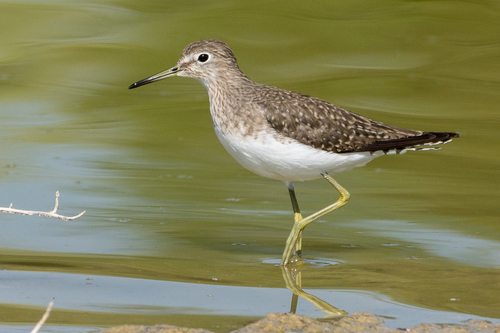
Solitary Sandpiper
The Solitary Sandpiper (*Tringa solitaria*) is a small shorebird known for its preference for secluded freshwater habitats, unlike many other sandpipers that frequent coastal areas. It plays a crucial role in its ecosystem by controlling insect populations and serving as prey for larger animals. While not holding significant cultural importance in many areas, its unique nesting habits and subtle beauty have made it a subject of interest for ornithologists and birdwatchers.
18-23 cm
Length
50-55 cm
Wingspan
Least Concern
Conservation Status
Distribution
Breeds across North America, from Alaska and Canada down to the northern United States. Winters in Central and South America, extending as far south as Argentina. Migrates through a broad swath of North and South America.
Lifespan
Unknown, but likely similar to other small sandpipers (around 8-10 years)
Solitary Sandpiper's Habitat
Habitat Types
Wooded freshwater wetlands, Ponds, Marshes, Bogs, Streamsides
Climate Zones
Boreal, Temperate, Tropical
Adaptations
Their preference for wooded wetlands and solitary behavior reduces competition with other shorebird species. Their long legs and bill are adapted for probing in mud and shallow water.
Variations
Two subspecies are generally recognized: *T. s. solitaria* and *T. s. cinnamomea*, with the latter being slightly larger and having a more cinnamon-colored plumage during the breeding season.
Appearance
Breeding Plumage
Breeding plumage features a dark brown back with white speckling, a white eye-ring, and streaked breast. Non-breeding plumage is duller, with less distinct markings.
Seasonal Feather Changes
Changes between breeding and non-breeding plumage are gradual, with molting occurring before and after migration.
Sex Based Plumage Differences
Minimal; males and females have similar plumage.
Notable Features
White eye-ring, Dark legs, White underparts, White rump visible in flight
Diet and Feeding
Primary Foods
Insects, Crustaceans, Mollusks, Small invertebrates, Occasionally small fish or tadpoles
Foraging Behavior
Typically forages by probing in mud or shallow water, picking prey from the surface, or wading in shallow areas. Often bobs its head and body while foraging.
Specializations
Its relatively long bill allows it to probe deeper into mud than some other small shorebirds.
Seasonal Diet Variations
Diet may shift slightly depending on prey availability during migration and in different parts of its range, but generally remains focused on invertebrates.
Behavior
Social Structure
Generally solitary, except during breeding season. May form small, loose flocks during migration.
Communication
A distinctive, ringing 'peet-weet' call, A faster, twittering call during flight displays, Visual displays, such as bobbing and wing fluttering
Migration
Migrates long distances, often at night. Individuals may use the same stopover sites year after year.
Territorial or Group Behaviors
Territorial during breeding season, defending the area around the nest. Otherwise, generally not strongly territorial.
Conservation
Threats
Habitat loss and degradation (especially of wetlands), Climate change (affecting breeding and wintering habitats), Pollution (contaminating food sources)
Protection Programs
Wetland conservation initiatives (e.g., Ramsar Convention), Migratory Bird Treaty Act (in North America)
Local National Laws
Protected under various national and international laws related to migratory birds.
Population Trend
Stable
Population Estimates
Global population estimated at around 450,000 individuals.
Interesting Facts
They are one of the few shorebirds that nest in trees.
This unusual nesting habit sets them apart from most other sandpipers, which nest on the ground.
They are known for their 'bobbing' behavior.
This characteristic up-and-down movement of the head and body is thought to help them spot prey or assess their surroundings.
The name 'solitaria' refers to its solitary habits.
Unlike many shorebirds, they are often seen alone rather than in large flocks.
Faqs about Solitary Sandpiper
Where can I see a Solitary Sandpiper?
Look for them near secluded freshwater habitats like ponds, marshes, and streamsides, especially during migration.
Do Solitary Sandpipers migrate?
Yes, they are long-distance migrants, breeding in North America and wintering in Central and South America.
Are Solitary Sandpipers endangered?
No, they are currently classified as 'Least Concern' by the IUCN, but their populations are vulnerable to habitat loss and climate change.
Copyright @ Nature Style Limited. All Rights Reserved.
 English
English